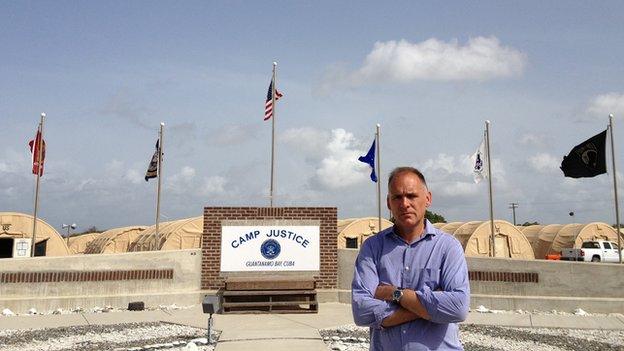What's going on at Guantanamo Bay?
- Published

Inmates are aware President Obama has promised to close Guantanamo Bay, but some see the hunger strike as an effort to speed up that process, says the BBC's Jonathan Beale reporting from Guantanamo
The BBC's Jonathan Beale is at the US military prison of Guantanamo Bay in Cuba reporting on the ongoing hunger strike.
It is the longest hunger strike in Guantanamo's history, with more than 100 detainees refusing food.
Thirty-six people are being tube fed and five have been hospitalised as part of protests against the conditions in the prison.
President Obama faces continuing pressure to close the jail and make alternative arrangements for the 86 detainees, who have been cleared for transfer.
From the prison Jonathan Beale answered some of your questions about Guantanamo Bay.
This is an edited version of the Twitter Q&A held on Thursday 6 June, 2013:
Question, external from @Sean_Noo_Noo:How big is a cell and how many prisoners per cell?
Jonathan answers, external: Individual cells are the same size as a standard federal prison. They have a mattress, a toilet and a sink.
Jonathan continues, external: Each prisoner is locked up in a single cell and currently most are locked up for 22 hours per day.
Question, external from @pavitarmann: What exactly does 'cleared for release' mean? Not enough evidence 2 convict? Where will prisoners go?
Jonathan answers, external: The US Military doesn't use the term cleared for release, it says some prisoners, around 80, have been cleared for transfer.
Jonathan continues, external: It's possible some detainees are transferred to their country of origin but US Congress has opposed transfers to US mainland.
Question, external from @DrTluther: When you're at Gitmo, can you go to Cuba and then return? And how is it the US has this base still?

Obama says the prison is seen as a sign around the world that America flouts the rule of law
Jonathan answers, external: No. There's a security perimeter that divides the US military base from the rest of Cuba.
Jonathan continues, external: Back in the 19th century the US negotiated a lease with Cuba for the base which has long been home to US Navy.
Jonathan continues, external: In theory it pays a small sum to Cuba for the annual lease, but Communist Cuba refuses to cash the cheque.
Question, external from @Jade_Nicole: How much free time outside their cells do they have and what can they do?
Jonathan answers, external: The minority of prisoners who are deemed "compliant" can live communally, watch TV, take classes in art & languages.
Question, external from @Ni4Neye: My question is why does America have to feed them, it's their choice not to eat. Why don't we just let them die?
Jonathan answers, external: US Military says it wants to treat them humanely. Some detainees committed suicide, but US says it wants to keep them alive.
Tim Stone emails, external: How much damage has been done to America's reputation by this camp?
Jonathan answers, external: Obama thinks it's damaged US reputation - hence his promise to close it down. So far US Congress has blocked Gitmo closures.
Nick Atkinson emails, external: Why is this detention facility still open?
Jonathan answers, external: US Congress has blocked moves to close it. Polls suggest most Americans would rather they were in Gitmo than moved to US.
Jonathan Beale visits "Camp Five" where the Guantanamo hunger strike started
Kat Devlin emails, external: Are detainees aware that many people in US are disgusted with the government and want the prison closed?
Jonathan answers, external: Prisoners aware that Obama promised to close it, some see the current hunger strike as an effort to speed up that process.
Dinka Aliap Chawul asks, external on Facebook: What will America do with detainees if the bay is closed?
Jonathan answers, external: Obama has suggested transferring some detainees to be tried in US Federal courts, but so far that's been resisted.
Jeremiah La Plante emails, external: How does the military's force-feeding programme work exactly?
Jonathan answers, external: Prisoners who refuse 9 successive meals or whose body weight drops a lot are offered a formula.
Jonathan continues, external: If they refuse, a tube is inserted through their nose into their stomach while being restrained.
Question, external from @PerryMHewitt: If it closes, what will happen to the land? Presumably a return to Cuba is out of the question?
Jonathan answers, external: Yes. US Navy still wants to retain the base as a deep water port in the Caribbean.
Jack Wedgwood emails, external: How do the guards feel about the prisoners' hunger strike?
Jonathan answers:, external Guards say they're just doing their job. Some say they've been abused and attacked by prisoners.
Jonathan continues, external: Other guards think it's a stunt to speed up the closure. Medical staff are frustrated that some prisoner refuse their help.
Question, external from @eveedream: Are there any dogs on site and if so how are they used?
Jonathan answers, external I've seen plenty of banana rats and iguanas but no dogs.
- Published6 June 2013
- Published30 April 2013
- Published30 April 2013